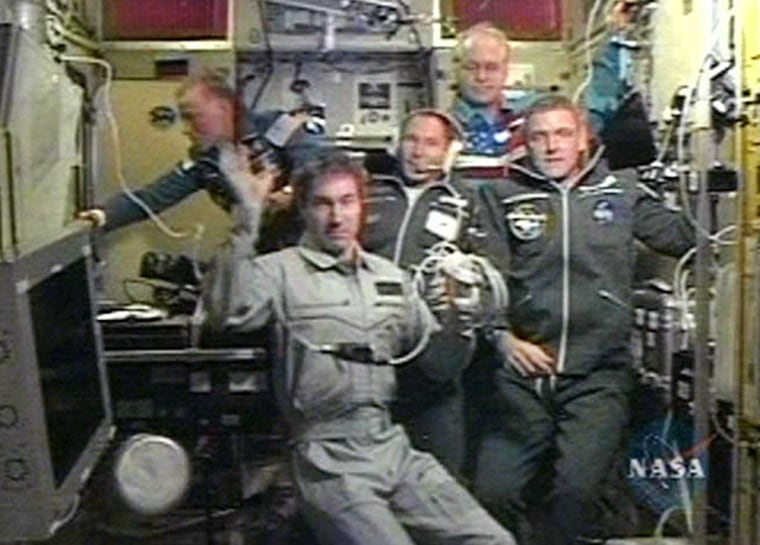American millionaire space traveler Gregory Olsen floated into the international space station Monday, welcomed by the outpost’s two-man crew with the traditional Russian greeting of bread and salt.
Two days after blasting off from Kazakhstan, a Soyuz capsule carrying the New Jersey scientist, as well as American astronaut William McArthur and Russian cosmonaut Valery Tokarev, hooked up with the station 250 miles (400 kilometers) above Earth at 1:27 a.m. EDT, about five minutes ahead of schedule.
With the arrival, Olsen became the third private citizen to visit the orbiting station, having paid $20 million to become what he calls a “spaceflight participant.”
Olsen’s relatives and U.S. and Russian space officials applauded as the capsule’s docking was announced at Mission Control in Korolyov outside Moscow.
“He’s never felt better,” said Krista Dibsie, Olsen’s 31-year-old daughter.
As her 4-year-old son Justin sat on her lap, holding crayon drawings of rockets, she said: “I can’t wait to see him back on Earth.”
The docking was conducted automatically. Technical problems have forced some previous capsule pilots to dock manually, a tense procedure that risks damaging the station.
Hugs, bread and salt
About three hours later, the crews opened the air locks and the Soyuz passengers met face-to-face with Russian Sergei Krikalev and American John Phillips, who have inhabited the station since April.
Russian TV showed Olsen carrying a video camera as he floated into the station, where he bumped his head on the ceiling. Krikalev and Phillips welcomed the three Soyuz travelers with hugs and the packets of bread and salt.
Later, the five men were shown posing for photographs, waving and smiling.
The Itar-Tass news agency said Olsen also spoke briefly to his daughter and grandson after boarding.
Olsen will conduct scientific experiments, learn emergency procedures and help out with some of the station’s operations before he, Krikalev and Phillips leave for Earth on Oct. 11.
McArthur and Tokarev will remain behind for the next six months. They will conduct at least two spacewalks, as well as scientific experiments, medical checks, tests of various metals and building materials and routine maintenance of the space station.
Reliance on the Russians
The United States has depended on Russian Soyuz and Progress craft to ferry astronauts and supplies to the space station since the 2003 Columbia disaster grounded the shuttle fleet. Discovery visited the station in July, but problems with the fuel tank foam insulation have raised questions on when the shuttle would fly again.
On the eve of blastoff, Russian space officials warned that they could not guarantee that an American would replace McArthur next spring unless NASA paid for the flight.
A U.S. law passed in 2000 bans payments to Russia in connection with the space station unless the president determines that Moscow is taking steps to prevent transfers to Iran of weapons of mass destruction, missile technology and advanced conventional weapons technology.
Russia is helping Iran build an $800 million nuclear power plant, despite concerns that Iran will use the project to help develop nuclear weapons.
The U.S. Senate has agreed to amend the measure and lift a ban on NASA purchases of Soyuz seats until 2012. The House has yet to act on it.
Return trip assured ... eventually
McArthur will get home one way or another, said William Gersteinmaier, NASA’s international space station program manager. However, he would not say whether the astronaut would be able to return on schedule in April.
Regarding McArthur’s return, Anatoly Perminov, chief of the Russian space agency, said: “There are no technical questions. As for political questions, NASA’s administration today is resolving them in a positive manner.”
Perminov also said that the European Space Agency, which has had astronauts on the station in the past, could send up another astronaut as early as the end of 2006.
The Russian space agency has turned to space tourism to generate extra money. Prior to Olsen, the station was visited by California businessman Dennis Tito in 2001 and South African Mark Shuttleworth a year later. All the visits were brokered by the Virginia-based company Space Adventures.
